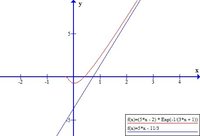Thanks everybody for help!
I would begin by writing the function as:
It was a pleasure to read your solution. And I learned some useful tricks. Thank you!
we need to find a solution to the limit that is first order in x
Sorry, I didn't get it. What does "first order in x" mean? I googled this word, and the results were vague. Is it derivative? But when finding the derivative, they divide a small change in f(x) by small change in x, and find the limit. In our case we divided function value by x.
You're right, I don't know anything about expansions. We've studied The Taylor series for the exponential, but we weren't told about The Taylor series in general.
I'm not fond of the method used by the instructor.
To be fair, the instructor doesn't teach us this method for getting the slant asymptote. I read it in a textbook. What about L'Hospital's rule, teacher thinks that it makes solving "algorithmic" and boring.
Also, I found another solution, but I'm not sure.
[MATH](5x-2)e^{-\frac{1}{3x+1}}=5x(e^{-\frac{1}{3x+1}}-1)-2e^{-\frac{1}{3x+1}}[/MATH][MATH]e^x\sim1+x[/MATH] as [MATH]x\to0[/MATH], so in the limit we can replace [MATH](e^{-\frac{1}{3x+1}}-1)[/MATH] with the [MATH]-\frac{1}{3x+1}[/MATH].
[MATH]\lim_{x\to\infty}(-\frac{5x}{3x+1}-2e^{-\frac{1}{3x+1}})[/MATH] is easy.
Am I right?

